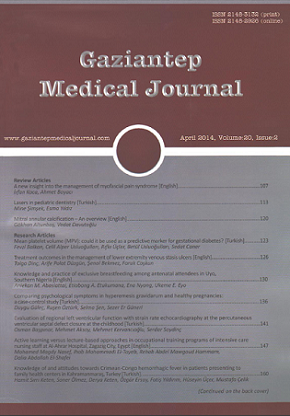Treatment outcomes in the management of lower extremity venous stasis ulcers
Alt ekstremite venöz ülserlerinde tedavi yaklaşımımız ve sonuçlarımızAlt ekstremite venöz ülserlerinde tedavi yaklaşımımız ve sonuçlarımız
DOI:
https://doi.org/10.5455/GMJ-30-45332Keywords:
Choronic wound treatment, compression, varices, venous leg ulcersAbstract
The aim of the study is to present the treatment outcomes in patients with venous stasis ulcer and summarize results with a brief review of the literature. Thirty patients with venous leg ulcers referred to a single chronic wound care unit with a minimum one year follow-up were included. Demographic features, co-morbidities, localization and characteristics of the ulcerated lesions, symptoms, arterial and venous Doppler ultrasound examination results, wound culture results, and outcomes of medical and surgical treatments were summarized. The treatment approach includes treating superficial and deep infections, obtaining tissue revascularization, compression, daily wound care, oral pentoxifylline, reconstruction of the major skin defects with split thickness skin grafts and hyperbaric oxygen therapy in refractory lesions. Mean age was 54 (32-85). Male to female ratio was 87%. Most common symptom was edema (83%). Mean size of ulcers were 20 cm² (4- 45). Seven (23%) patients were hospitalized. Eighty % of patients had venous insufficiency. Most common isolated pathogen was P. aeruginosa (23%). Most common complication was osteomyelitis (5%). Hyperbaric oxygen therapy was applied to 3 patients. Split thickness grafts were used for the treatment of the skin defects in six (%20) patients. There was no recurrence of lesion in any patients at one year follow-up. Despite chronic lower extremity venous stasis ulcers are difficult to treat and related with a high risk of recurrence, it is possible to obtain good results with patient education and a systematic treatment approach.
Metrics
References
Callam MJ. Prevalence of chronic leg ulceration and severe chronic venous disease in Western countries. Phlebology 1992;7(Suppl. 1): 6-12.
de Araujo T, Valencia I, Federman DG, Kirsner RS. Managing the patient with venous ulcers. Ann Intern Med 2003;138(4):326-34.
Moffatt CJ, Franks PJ, Doherty DC, Martin R, Blewett R, Ross F. Prevalence of leg ulceration in a London population. QJM 2004;97(7):431-7.
Cornwall JV, Dore CJ, Lewis JD. Leg ulcers: epidemiology and aetiology. Br J Surg 1986;73(9):693-6.
Callam MJ, Ruckley CV, Harper DR, Dale JJ. Chronic ulceration of the leg: extent of the problem and provision of care. Br Med J (Clin Res Ed) 1985;290(6485):1855-6.
Ruckley CV. Socioeconomic impact of chronic venous insufficiency and leg ulcers. Angiology 1997;48(1):67–9.
Valencia IC, Falabella A, Kirsner RS, Eaglstein WH. Chronic venous insufficiency and venous leg ulceration. J Am Acad Dermatol 2001;44(3):401-21.
Persoon A, Heinen MM, van der Vleuten CJ, de Rooij MJ, van de Kerkhof PC, van Achterberg T. Leg ulcers: a review of their impact on daily life. J Clin Nurs 2004;13(3):341-54.
O'Meara S, Al-Kurdi D, Ologun Y, Ovington LG, Martyn-St James M, Richardson R. Antibiotics and antiseptics for venous leg ulcers. Cochrane Database Syst Rev 2014;1:CD003557.
Pappas PJ, Lal BK, Ohara N, Saito S, Zapiach L, Durán WN. Regulation of matrix contraction in chronic venous disease. Eur J Vasc Endovasc Surg 2009;38(4):518-29.
Bergan JJ, Schmid-Schönbein GW, Smith PD, Nicolaides AN, Boisseau MR, Eklof B. Chronic venous disease. N Engl J Med 2006;355(5):488-98. 12. Petherick ES, Cullum NA, Pickett KE. Investigation of the effect of deprivation on the burden and management of venous leg ulcers: a cohort study using the THIN database. PLoS One 2013;8(3):e58948.
Briggs M, Nelson EA, Martyn-St James M. Topical agents or dressings for pain in venous leg ulcers. Cochrane Database Syst Rev 2012;11:CD001177.
Cullum NA, Al-Kurdi D, Bell-Syer SE. Therapeutic ultrasound for venous leg ulcers. Cochrane Database Syst Rev 2010;(6):CD001180.
Briggs M, Nelson EA, Martyn-St James M. Topical agents or dressings for pain in venous leg ulcers. Cochrane Database Syst Rev. 2012 Nov 14;11:CD001177.
Palfreyman SJ, Nelson EA, Lochiel R, Michaels JA. Dressings for healing venous leg ulcers. Cochrane Database Syst Rev 2006;(3):CD001103.
Jull AB, Arroll B, Parag V, Waters J. Pentoxifylline for treating venous leg ulcers. Cochrane Database Syst Rev 2012;12:CD001733.
Wilkinson EA, Hawke CI. Oral zinc for arterial and venous leg ulcers. Cochrane Database Syst Rev 2000;(2):CD001273.
Adkinson C. Hyperbaric oxygen for treatment of problem wounds. Minn Med 2011;94(9):41-6.
Tawfick WA, Sultan S. Technical and clinical outcome of topical wound oxygen in comparison to conventional compression dressings in the management of refractory nonhealing venous ulcers. Vasc Endovascular Surg 2013;47(1):30-7.
Jones JE, Nelson EA, Al-Hity A. Skin grafting for venous leg ulcers. Cochrane Database Syst Rev 2013;1:CD001737.
Downloads
Published
How to Cite
Issue
Section
License
Copyright (c) 2023 European Journal of Therapeutics

This work is licensed under a Creative Commons Attribution-NonCommercial 4.0 International License.
The content of this journal is licensed under a Creative Commons Attribution-NonCommercial 4.0 International License.


















